features
Why Britain’s boxed sandwich game is totally unrivalled
27 May 2022
8m
If you were asked to name a quintessentially British meal, you’d likely suggest a roast dinner or a chippy tea, and you’d be right, of course.
But there’s another contender for the crème de la crème of British cuisine – the best thing since sliced bread, and not just because it’s made of the stuff.
In case you haven’t guessed, we’re talking about the sandwich (or sarnie, or bap, or whatever you call it, really). You see, the sandwich is so cherished across Britain that it goes by a whole plethora of nicknames these days.
Simply protein, salad and some sort of sauciness stuffed in between two slices of bread, it couldn’t be easier to make one for ourselves at home, and yet we still buy the boxed ones en masse every lunchtime, spending a staggering £8 billion a year.

Britain’s supermarket sandwiches are in their own league (Credit: Alamy)
Ploughmans, BLT and ham and cheese – they’re all daily staples for millions of us around the country, and supermarkets and cafes are thriving off them. Which got us wondering, just when did the humble boxed sandwich become such a lunchtime institution, and why do we love them so damn much?
In honour of British Sandwich Week, we decided to do a comprehensive deep-dive.
The birth of the boxed sandwich
The boxed sandwich is enjoyed across the world today, but like the sandwich itself, which was invented by a British Earl in the 60s, the new pre-packed iteration was also born here.
When they first launched, there were many who doubted they’d take off as a food-to-go item. After all, as many as 70 per cent of workers in big cities typically went home for lunch, and those who didn’t would primarily eat in staff canteens or bring their own packed lunches in.
But it was the good folks at Marks & Spencer who went against the grain and brought it to the high-street 42 years ago, selling them with cheap white bread and just one option of filling at under 50p a pop.
A year after their conception, lunchtime sandwiches had become such a staple in M&S’ around Britain that the department store industrialised the process, and the boxed sandwich was born. Then, almost instantaneously, other supermarkets and cafes started following suit, and in the blink of an eye, our lunchtimes were changed forever.
Owen Lilley, product developer for M&S, says there’s no question they started a “food revolution” when they launched grab and go sandwiches back in the 80s.
“Who would have thought a humble salmon and tomato sandwich – our first ever flavour – would go on to fundamentally change the way the nation eats?,” he reflects, in a chat with Twisted.
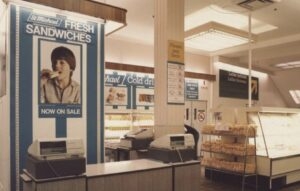
Marks & Spencer was the first to launch the boxed sandwich (Credit: M&S/ Twitter)
“Since then, the M&S sandwich has become part of Britain’s cultural heritage and we’ve sold over 4 billion sandwiches since 1980.
“In 1981 we introduced our prawn mayonnaise and it’s been our best-seller ever since”.
“That was a turning point where the industry started to really flourish,” confirms Jim Winship, founder of the British Sandwich Association. “Because people realised there was an opportunity to develop the market in a more structured way.
“When M&S launched it, others saw the opportunity and got into the market and the whole thing started to really take off.”
At that point, the lunch hour had already been shrinking for years, and M&S’ grand idea struck a chord with many who were working longer hours and needed an instant, functional fix.
“The world was changing, and M&S came along at just the right time to and offered something that fitted the demand,” he says. “People realised they wanted something affordable that could eat on the move, which fitted their busy, working lifestyles.
“Even today, convenience is very much part of the driving force in the food industry now, but it all evolved from the packaged sandwich.”
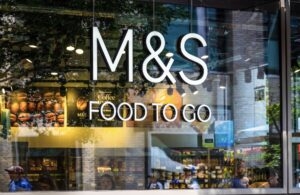
M&S kickstarted Britain’s food-to-go industry (Credit: Alamy)
The evolution of the takeaway sandwich
A decade after M&S’ very first salmon sandwich, there were shops like Pret and Costa on every corner, capitalising on our new appetite for an instant lunch, each racing to innovate faster than the other and bring out their own take on the lunchtime favourite.
Explaining why he decided to throw his hat into the sandwich game at the time, Julian Metcalfe OBE, founder of Pret A Manger, says: “At one point, the only place you could get a sandwich was M&S.
“So, we just saw an opportunity to take an affordable food, which was still pretty boring, and make it into something which was exciting – and the country really responded to it.
“The plan was to kind of revolutionise the sandwich with better, really good quality fillings, fresh, thick bread – we baked baguettes, we bought all these ovens from France – the best ham, chicken, and salad…
“Then, we added new stuff, like crayfish and rocket and all these things people haven’t heard of. It just took off like crazy.”
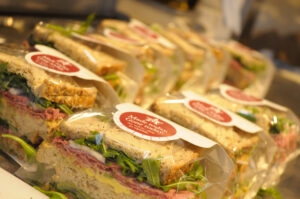
Sandwich shops soon came along and innovated (Credit: Alamy)
After Pret came the likes of Subway (the biggest sellers of lunchtime sandwiches in Britain today), and as more players entered our sandwich market, this evolution that Metcalfe talks of has undoubtedly remained key.
For one, we’ve seen Christmas Sandwiches become a nationwide phenomenon, and that’s before we even mention all the other quirky variations of fillings that have also graced our shelves – some standing the test of time, and some slipping quietly off the radar, like they never happened (ahem, Tesco strawberries and cream sandwich, we’re looking at you…)
Metcalfe’s drive to bring new and different products to the market ultimately drew him away from Pret and led him to open Itsu, where he proudly professes to be evolving the sandwich further by bringing the Asian bao to his chain.
Whether you believe the bao to be a sandwich or not (Metcalfe does), he says it’s a sign that our palates are becoming more complex, thanks to the ever-increasing diversity of the restaurants cropping up, and also how well travelled we are.
“We go on holiday much more than we did,” he says. “And if you go to Thailand or Cambodia, and you eat the food, that’s it… you’ll never look back.
“You’ll hunt it out because it’s delicious.”
The Itsu founder says it’s for this reason there’s more pressure on high-street brands to bring people new flavours as part of a lunch-time offering, and he firmly believes it’s the way that boxed sandwiches are moving, too.
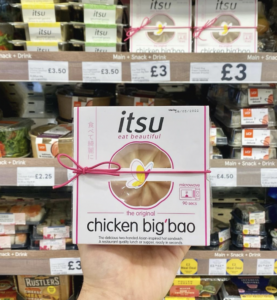
Metcalfe said the boxed sandwich is changing as our tastes develop (Credit: Itsu/ Instagram)
Indeed, company leaders at his former haunt, Pret, seem to echo his sentiments. Katherine Bagshawe, UK Food and Coffee Director at the chain today, professes: “We like to think we’re popular because we fundamentally offer customers food and drinks they love while also keeping a close eye on new trends to evolve with their preferences.
“We are frequently updating our menu of classic sandwiches with new and exciting flavours, for example, in May this year we launched a new spring menu that featured hand crafted rye rolls for the first time, and using bold filings inspired from culinary destinations around the world.”
Meanwhile, M&S’ representative, Lilley, says that new and diverse flavours are currently more of a focus than ever.
“While we’ve kept some of our staples like ham & mustard and the BLT around for decades now, we know our customers also like to try new things, especially flavours they might have enjoyed at restaurants or street food markets,” he says.
“That’s why from this summer we’re introducing a new Limited Edition sandwich every few months that will tap into the latest food trends, starting with our delicious new Buttermilk Fried Chicken Burger roll with Carolina-style BBQ sauce, charred slaw and Swiss cheese.”
Why Britain still dominates the boxed sandwich game
It certainly looks like the takeaway sandwich may well evolve further beyond its box in the next few years, but as Winship explains, such innovation is only possible thanks to the monstrous demand.
The average Brit is expected to eat around 18,304 sandwiches in a lifetime, spending upwards of £48,339 on the takeaway lunch option.

Sandwiches have become a functional part of our working day (Credit: Alamy)
“The sandwich was a British invention anyway, but we also did lead the introduction of ready made sandwiches as we know them today in the UK, and that market evolved here,” he adds. “So it’s not surprising that we’re ahead of everyone else when it comes to innovation.
“The quantity of products here are phenomenal nowadays compared to other countries who sell sandwiches but don’t quite look at them in the same way.”
“As a nation, we’re pretty unique when it comes to our love of supermarket sandwiches,” agrees Lilley. “This is in part because we’re happy to take our lunch break at our desks or on the go, which isn’t the culture in many other countries.”
Of course, there are logistical reasons our boxed sandwich sales also swamp the rest of Europe, too.
“We have a very sophisticated chilled food market here, which is much more advanced than many other places in the world,” Winship says.
“I think it’s partly due to the way population centres operate. If you compare the UK to, say, France…here, you’ve got very dense populations in areas where you can distribute and get volume sales fairly easily, whereas in France, the distances are much greater in terms of the nearest service stations [and city centres]… so, distribution is a big component to it.”
For all of these reasons, we’ve barely seen any faltering in the success of the boxed sandwich. In fact, it seemed an unstoppable force, with sales growing at 2 percent (that’s a rate of 80 million sandwiches) per year.
Whilst the Covid-19 pandemic did cause the food-to-go industry falter for two years, Winship says its rapid comeback is the most obvious sign of our loyalty to the humble sarnie.
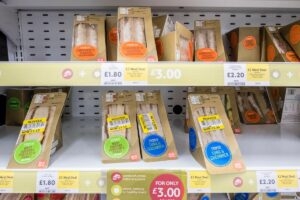
Boxed sandwiches will always have a place in Brits’ hearts (Credit: Alamy)
“The market is already back by about 80 percent from where it was in 2019,” he says. “And that’s despite the fact many people are still working from home and our environments have changed.
“[The sandwich remains the main draw for consumers], because there’s nothing like it, really. You can eat it on the move, and it’s a meal that is balanced, and has everything in it from fibre to protein to interesting flavour combinations.”
There’s no denying that for many of us Brits, the boxed sandwich is and will always be a lunchtime saviour.



.jpg_dU0O4c?tr=w-2560,f-webp,q-70)